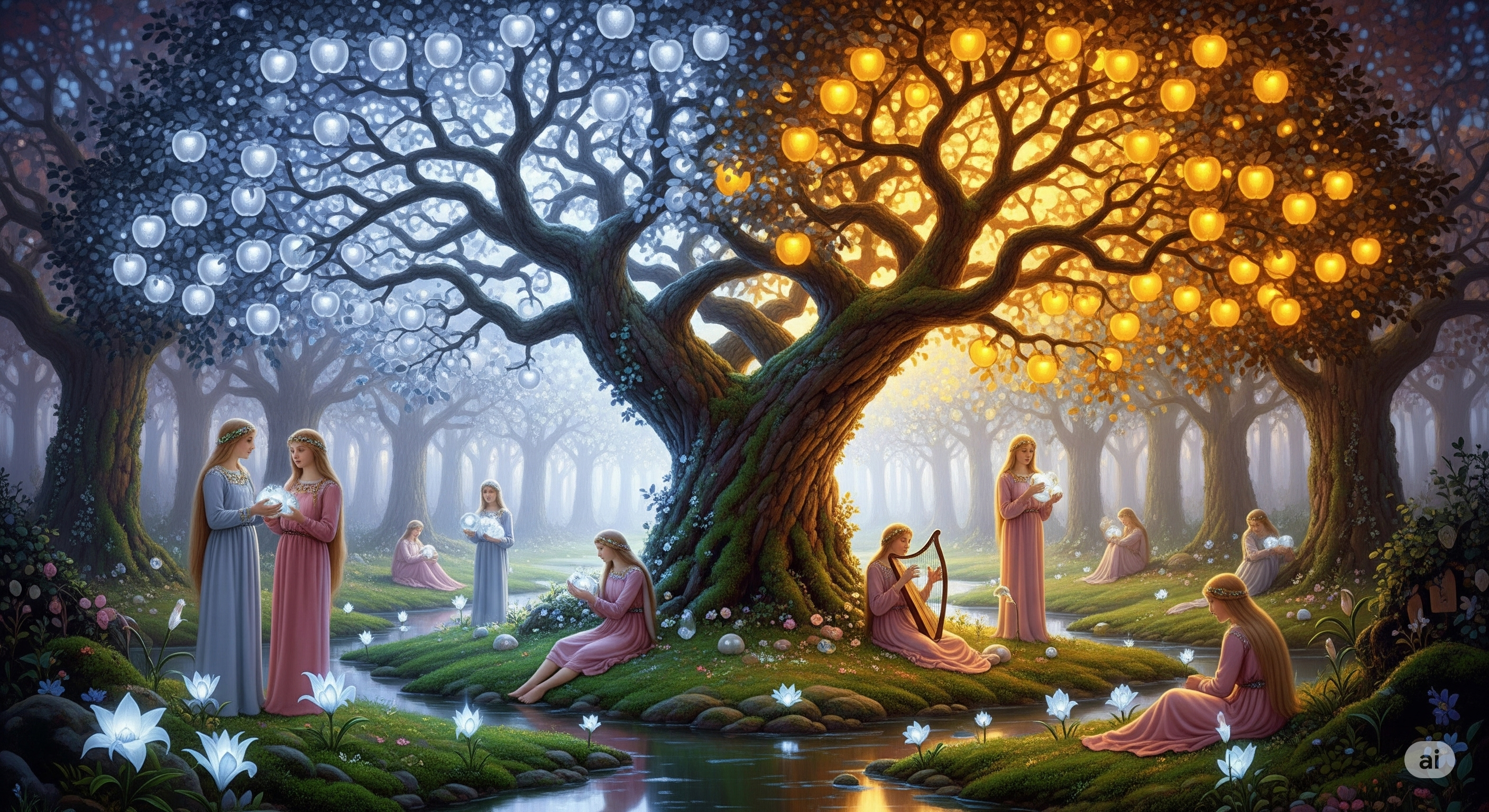Tír Na NÓg is a supernatural realm in Irish mythology. Its name translates to "Land of Perpetual Youth," and it is generally depicted as a place of eternal youth, beauty, health, abundance, and joy. In this land, there is no sorrow or death, and time operates differently than in the mortal world. It is known as the home of the Tuatha Dé Danann, the gods of pre-Christian Ireland.

The Sacred Orchard and Timeless Life at the Heart of Tír Na NÓg (Created with Artificial Intelligence)
Definition and Mythological Context
Tír Na NÓg is an otherworldly realm, often located across the sea or as a hidden island. Access for mortals is limited and typically requires a magical guide or vessel. In the legends, this journey is often made on Enbarr, a magical horse used by the Tuatha Dé Danann that can travel over both land and sea.
The inhabitants of Tír Na NÓg, sometimes referred to as "the good people" or fairies, are described as semi-divine, semi-human beings. It is said that these beings reward those who do them a good turn but are implacable in their anger and seek revenge against those who offend them. Their primary pastimes consist of feasting and dancing.
The Narrative of Oisín and Niamh
The most common narrative associated with Tír Na NÓg is the story of the warrior-poet Oisín and Niamh, one of the queens of the realm. Oisín was a member of the Fianna, an elite band of warriors, and the son of their leader, Fionn mac Cumhail.
In the legend, Niamh is described as a beautiful woman with golden hair who arrives from across the sea on a white horse to find Oisín. Having heard of his prowess, she invites him to come with her to Tír Na NÓg. Oisín accepts and travels with her across the waves.
Oisín lives with Niamh in Tír Na NÓg, and they have three children. Although his time there seems to him to be only three years, 300 years have actually passed in Ireland. Eventually, Oisín becomes homesick for his father and comrades and asks to visit Ireland. Niamh permits him to go on the condition that he does not set foot on the soil of Ireland, warning that if he does, he will never be able to return.
Oisín returns on the white horse to find his country completely changed and unrecognizable. The forts of the Fianna are in ruins, and the people are small and weak. As he is about to return, he leans down from his saddle to help some men move a large boulder. As he lifts it, the saddle girth breaks, and he falls to the ground. The moment he touches the earth, the hundreds of years catch up with him, and he instantly becomes a withered, ancient man. The horse gallops away, and Oisín dies after recounting his story and the tales of the Fianna.
Folkloric Beliefs and Metaphorical Interpretations
Tír Na NÓgand its inhabitants have been the source of various beliefs in Irish folklore. According to these beliefs, fairies can snatch mortals away to their realm, sometimes because an elfin prince or fairy woman has fallen in love with a mortal. Figures known as "fairy doctors" are believed to be familiar with the fairies and able to lift enchantments. It is also a common belief that one should not demolish fairy forts (raths) or disturb their grounds, lest misfortune befall the offender.
Beyond its mythological role, Tír Na NÓg also carries a metaphorical meaning. In this interpretation, the land represents the lost innocence and wonder of childhood, where joy is found in simple things. This state is contrasted with the disillusionment and weariness of the adult world, which is seen as a self-imposed exile from this land of joy.
Reflections in Art and Culture
The legend of Tír Na NÓg has served as an inspiration for various works of art. A notable example is Michael Romney's 2017 Master of Fine Arts thesis, which centers on a choreography based on the legend. In this work, the story of Oisín and Niamh is told through a combination of traditional and contemporary Irish dance, contemporary ballet, and modern dance techniques. The choreography is structured in three major sections representing ancient Ireland, Tír Na NÓg, and modern-day Ireland, using different dance styles to visualize the transitions between the distinct realms and time periods of the legend.

